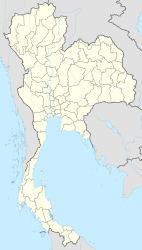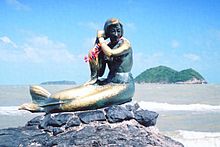Songkhla
|
สงขลา Songkhla |
||
|---|---|---|
|
|
||
| Coordinates | 7 ° 11 ′ N , 100 ° 36 ′ E | |
| Symbols | ||
|
||
| Basic data | ||
| Country | Thailand | |
| Songkhla | ||
| ISO 3166-2 | TH-90 | |
| Residents | 68,725 (2012) | |
|
Songkhla city view
|
||
Songkhla ( Thai : สงขลา ; formerly Singhala , "City of Lions"; Malay Singora ) is the capital of the Songkhla Province in the southern region of Thailand . It is located in the district ( Amphoe ) Mueang Songkhla and has had the administrative status of a "big city municipality" ( Thesaban Nakhon ) since 1999 .
Songkhla has 68,725 inhabitants (as of 2012).
geography
Songkhla is located in the extreme south of the country on a headland between Lake Songkhla and the Gulf of Thailand . Songkhla Lake is part of the Thale Sap, a large lagoon connected to the ocean by a strait. It contains brackish water .
The distance (as the crow flies) to the capital Bangkok is about 720 km.
Due to its attractive location in the middle of water, Songkhla is one of the most beautiful seaside resorts in the country, but without taking a significant part in the tourist flow.
Economy and Transport
Songkhla is traditionally a port and trading city. Already in the 17th century it was an important center of overseas trade, for example with Japan and Europe (see under history). Even later it remained the central transshipment point for goods from the region, but also other parts of Thailand, China, Singapore and Penang . In addition, there was fishing, both on Lake Songkhla and in the Gulf, processing of the rice grown in the surrounding area, pottery and brick making, and orange cultivation.
Songkhla had a connection to the country's rail network through a branch line of the Southern Railway , which connects Bangkok with Malaysia . This branch line was closed on July 1, 1978.
history
Songkhla is one of the oldest cities in Thailand, it has been an important trading city for centuries.
In the course of its history, the city's location has shifted several times. At the foot of the Hua Khao Daeng (today's city of Singhanakhon) you can still see the old fortifications of the then city of Singora (a forerunner of Songkhla). In the 17th century, under the leadership of Muslim sultans, this was an important port city for overseas trade. Ships from Japan and Europe also called at the duty-free port to trade here, which brought great prosperity to the city. In 1642 the Sultan of Singora declared himself independent from the Siamese Ayutthaya . Ayutthaya's punitive expeditions failed for 38 years, and it was not until 1680 that the troops captured King Narais Singora and completely destroyed it. A contract to cede the place to the French East India Company failed because the French showed no interest in the destroyed and therefore useless port.
A new Songkhla was later built a few kilometers inland on Laem Son on the shores of Lake Songkhla. Due to the rather isolationist foreign and trade policy of Siam after the overthrow of 1688, however, it was unable to build on the earlier importance of Singora. In the years that followed, Songkhla was significantly influenced by Chinese immigrants, especially from Fujian Province (Hokkien). A Hokkien-Chinese family of traders and tax tenants took over the economic and - thanks to the appointment of Yiang Hao as governor by King Taksin in 1775 - also the political leadership. In 1842 the center of Songkhla was relocated again, this time to the other side of the waterway between Lake Songkhla and the open sea, to Bo Yang, where it is still today.
At the beginning of the Pacific War , Songkhla was one of the main landing sites for the Japanese to conquer the Malay Peninsula . They landed their troops at dawn on December 8, 1941, without much resistance, and from here they advanced further south.
Attractions
- Wat Matchimawat (also called Wat Klang) on Sai Buri Road - Buddhist temple ( wat ) from the 16th century. The ubosot dates from the time of King Nang Klao ( Rama III , ruled 1824–1851) and Mongkut ( Rama IV , ruled 1851–1868) and shows numerous frescoes in the Bangkok style ( rattanakosin style).
- Wat Chai Mongkhon on Phetmongkhon-Chaimongkhon Road has a chedi that contains a relic of the Buddha . This was brought from Sri Lanka by a monk named Na Issaro .
- Governor's Palace (National Museum) - Chinese-style building built in 1878 by the then governor of the province; today it is a museum and contains u. a. Bronze sculptures from the Srivijaya period (8th – 10th centuries) and ceramics from the Ayutthaya period.
- Has Samila ( Samila Beach ) - soft, white sand beach about three kilometers outside, with many pine trees. View of the offshore islands "cat and mouse". A large bronze statue of a mermaid at one end of the beach depicts a character from the story Phra Apaimanee by Sunthorn Phu .
Personalities
- Weerawut Kayem (* 1993), football player
- Tatchanon Nakarawong (born 1996), football player
- Adisak Sensom-Eiad (* 1994), football player
- Rittiporn Wanchuen (* 1995), football player
Web links
- City map of Songkhla (names in English and Thai) [last accessed November 17, 2013]
Individual evidence
- ↑ Department of Provincial Administration : As of 2012 (in Thai)
- ^ BR Whyte: The Railway Atlas of Thailand, Laos and Cambodia . White Lotus Co Ltd, Bangkok 2010, ISBN 978-974-480-157-9 , p. 54.
- ↑ Srisuporn Choungsakul: The Role of Chinese Traders on the Growth of Songkhla. In: Manusya - Journal of Humanities , Volume 9, No. 2, 2006, pp. 44-65. Archived from the original on January 2, 2014 ; accessed on November 29, 2015 .




